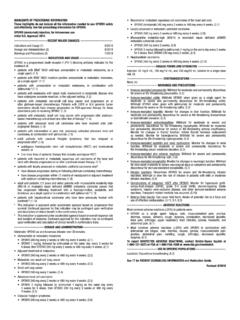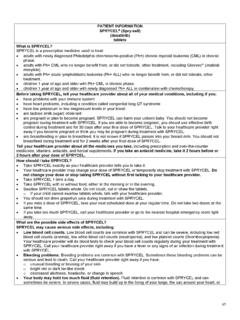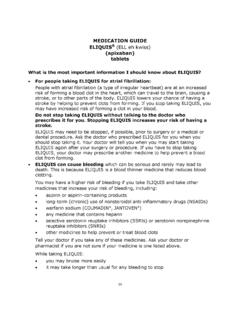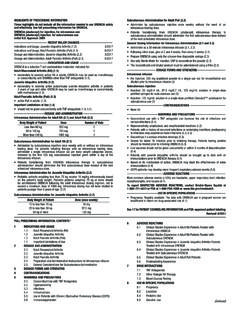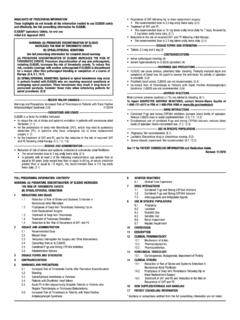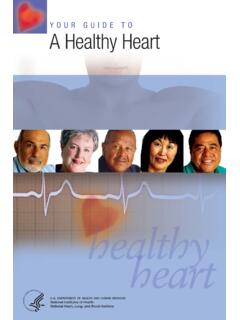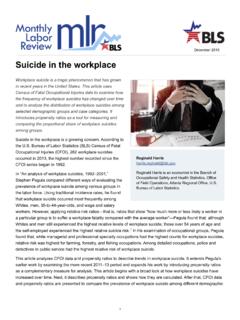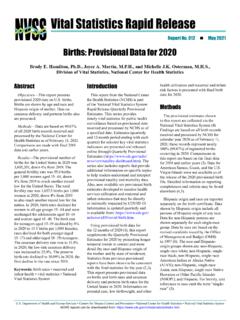Transcription of HIGHLIGHTS OF PRESCRIBING INFORMATION These …
1 HIGHLIGHTS OF PRESCRIBING INFORMATIONT hese HIGHLIGHTS do not include all the INFORMATION needed to use ONUREG safely and effectively. See full PRESCRIBING INFORMATION for (azacitidine) tablets, for oral useInitial Approval: 2004------------------------------INDICA TIONS AND USAGE ------------------------------ONUREG is a nucleoside metabolic inhibitor indicated for continued treatment of adult patients with acute myeloid leukemia who achieved first complete remission (CR) or complete remission with incomplete blood count recovery (CRi) following intensive induction chemotherapy and are not able to complete intensive curative therapy (1).--------------------------- DOSAGE AND ADMINISTRATION --------------------------- Do not substitute ONUREG for intravenous or subcutaneous azacitidine. The indications and dosing regimen for ONUREG differ from that of intravenous or subcutaneous azacitidine ( , ).
2 Administer ONUREG 300 mg orally once daily on Days 1 through 14 of each 28-day cycle ( ). Administer an antiemetic before each dose for at least the first 2 cycles ( ).-------------------------DOSAGE FORMS AND STRENGTHS -------------------------Tablets: 200 mg and 300 mg (3).--------------------------------CONT RAINDICATIONS --------------------------------History of severe hypersensitivity to azacitidine or its components (4).---------------------------WARNINGS AND PRECAUTIONS --------------------------- Risks of Substitution with Other Azacitidine Products: Do not substitute ONUREG (azacitidine) for intravenous or subcutaneous azacitidine ( , ). Myelosuppression: Monitor complete blood counts every other week for the first 2 cycles and prior to the start of each cycle thereafter. Increase monitoring to every other week for the 2 cycles after any dose reduction. Withhold and then resume at same or reduced dose or discontinue ONUREG based on severity ( , ).
3 Embryo-Fetal Toxicity: Can cause fetal harm. Advise patients of the potential risk to a fetus and use of effective contraception ( , , ).--------------------------------ADVERS E REACTIONS --------------------------------The most common adverse reactions ( 10%) are nausea, vomiting, diarrhea, fatigue/asthenia, constipation, pneumonia, abdominal pain, arthralgia, decreased appetite, febrile neutropenia, dizziness, and pain in report SUSPECTED ADVERSE REACTIONS, contact Bristol-Myers Squibb Company at 1-800-721-5072 or FDA at 1-800-FDA-1088 or IN SPECIFIC POPULATIONS ---------------------------Lactation: Advise not to breastfeed ( ).See 17 for PATIENT COUNSELING INFORMATION and FDA-approved patient labelingRevised: 10/2022 FULL PRESCRIBING INFORMATION : CONTENTS*1 INDICATIONS AND USAGE2 DOSAGE AND Important Administration Recommended Monitoring and Dosage Modifications for Adverse Reactions3 DOSAGE FORMS AND STRENGTHS4 CONTRAINDICATIONS5 WARNINGS AND Risks of Substitution with Other Azacitidine Increased Early Mortality in Patients with Myelodysplastic Embryo-Fetal Toxicity 6 ADVERSE Clinical Trials Postmarketing Experience8 USE IN SPECIFIC Females and Males of Reproductive Pediatric Geriatric Renal Hepatic Impairment11 DESCRIPTION12 CLINICAL Mechanism of Pharmacokinetics13 NONCLINICAL Carcinogenesis, Mutagenesis, Impairment of Fertility14 CLINICAL STUDIES15 REFERENCES16 HOW SUPPLIED/STORAGE AND HANDLING17 PATIENT COUNSELING INFORMATION *Sections or subsections omitted from the full PRESCRIBING INFORMATION are not PRESCRIBING INFORMATION1 INDICATIONS AND USAGEONUREG (azacitidine)
4 Is indicated for continued treatment of adult patients with acute myeloid leukemia who achieved first complete remission (CR) or complete remission with incomplete blood count recovery (CRi) following intensive induction chemotherapy and are not able to complete intensive curative DOSAGE AND Important Administration InformationDo not substitute ONUREG for intravenous or subcutaneous azacitidine. The indications and dosing regimen for ONUREG differ from that of intravenous or subcutaneous azacitidine [see Warnings and Precautions ( )]. Recommended DosageThe recommended dosage of ONUREG is 300 mg orally once daily with or without food on Days 1 through 14 of each 28-day cycle. Continue ONUREG until disease progression or unacceptable an antiemetic 30 minutes prior to each dose of ONUREG for the first 2 cycles. Antiemetic prophylaxis may be omitted after 2 cycles if there has been no nausea and the absolute neutrophil count (ANC) is less than Gi/L on Day 1 of a cycle, do not administer ONUREG (azacitidine).
5 Delay the start of the cycle until the ANC is Gi/L or patients on the following: Swallow tablets whole. Do not cut, crush, or chew the tablets. Take a dose about the same time each day. If a dose of ONUREG is missed, or not taken at the usual time, take the dose as soon as possible on the same day, and resume the normal schedule the following day. Do not take 2 doses on the same day. If a dose is vomited, do not take another dose on the same day. Resume the normal schedule the following is a hazardous drug. Follow applicable special handling and disposal Monitoring and Dosage Modifications for Adverse ReactionsMonitor complete blood count every other week for the first 2 cycles and prior to the start of each cycle thereafter. Increase monitoring to every other week for the 2 cycles after any dose reduction for recommended dosage modifications for adverse reactions are provided in Table (azacitidine)ONUREG (azacitidine)Table 1: Recommended Dosage Modifications for Adverse ReactionsAdverse ReactionSeverityRecommended Dosage ModificationMyelosuppression [see Warnings and Precautions ( )]Neutrophils less than Gi/L on Cycle Day 1 Interrupt treatment.
6 Resume at the same dose once neutrophils return to Gi/L or less than 1 Gi/L with fever at anytimeFirst Occurrence Interrupt treatment. Resume at the same dose once neutrophils return to 1 Gi/L or in 2 Consecutive Cycles Interrupt treatment. After neutrophils return to 1 Gi/L or higher, resume at reduced dose of 200 mg. If a patient continues to experience febrile neutropenia after dose reduction, reduce the treatment duration by 7 days. If febrile neutropenia reoccurs after dose and schedule reduction, discontinue less than 50 Gi/L with bleedingFirst Occurrence Interrupt dose. Resume at the same dose once platelets return to 50 Gi/L or in 2 Consecutive Cycles Interrupt dose. After platelets return to 50 Gi/L or higher, resume at reduced dose of 200 mg. If a patient continues to experience thrombocytopenia with bleeding after dose reduction, reduce the treatment duration by 7 days.
7 If thrombocytopenia with bleeding reoccurs after dose and schedule reduction, discontinue Toxicity [see Adverse Reactions ( )]Grade 3 or 4 Nausea or Vomiting Interrupt dose. Resume at the same dose once toxicity has resolved to Grade 1 or lower. If toxicity reoccurs, interrupt dose until resolved to Grade 1 or lower. Resume at reduced dose of 200 mg. If a patient continues to experience the toxicity after dose reduction, reduce the treatment duration by 7 days. If the toxicity continues or reoccurs after dose and schedule reduction, discontinue 3 or 4 Diarrhea Interrupt dose. Resume at the same dose once toxicity has resolved to Grade 1 or lower. If toxicity reoccurs, interrupt dose until resolved to Grade 1 or lower. Resume at reduced dose of 200 mg. If a patient continues to experience the toxicity after dose reduction, reduce the treatment duration by 7 days. If the toxicity continues or reoccurs after dose and schedule reduction, discontinue Adverse Reactions [see Adverse Reactions ( )]Grade 3 or 4 Interrupt dose and provide medical support.
8 Resume at the same dose once toxicity has resolved to Grade 1 or lower. If toxicity re-occurs, interrupt dose until resolved to Grade 1 or lower. Resume at reduced dose of 200 mg. If a patient continues to experience the toxicity after dose reduction, reduce the treatment duration by 7 days. If the toxicity continues or reoccurs after dose and schedule reduction, discontinue DOSAGE FORMS AND STRENGTHST ablets: 200 mg, pink, oval, film-coated tablet with debossed 200 on one side and ONU on the other side. 300 mg, brown, oval, film-coated tablet with debossed 300 on one side and ONU on the other CONTRAINDICATIONSONUREG is contraindicated in patients with known severe hypersensitivity to azacitidine or its components [see Adverse Reactions ( ), Description (11)].5 WARNINGS AND Risks of Substitution with Other Azacitidine ProductsDue to substantial differences in the pharmacokinetic parameters [see Clinical Pharmacology ( )], the recommended dose and schedule for ONUREG are different from those for the intravenous or subcutaneous azacitidine products.
9 Treatment of patients using intravenous or subcutaneous azacitidine at the recommended dosage of ONUREG may result in a fatal adverse reaction. Treatment of patients using ONUREG at the doses recommended for intravenous or subcutaneous azacitidine may not be not substitute ONUREG for intravenous or subcutaneous azacitidine [see Dosage and Administration ( )]. MyelosuppressionNew or worsening Grade 3 or 4 neutropenia and thrombocytopenia occurred in 49% and 22% of patients who received ONUREG, respectively. Febrile neutropenia occurred in 12%. A dose reduction was required for 7% and 2% of patients due to neutropenia and thrombocytopenia, respectively. Less than 1% of patients discontinued ONUREG due to either neutropenia or complete blood counts and modify the dosage as recommended [see Dosage and Administration ( , )]. Provide standard supportive care, including hematopoietic growth factors, if myelosuppression Increased Early Mortality in Patients with Myelodysplastic SyndromesIn AZA-MDS-003 (NCT01566695), 216 patients with red blood cell transfusion-dependent anemia and thrombocytopenia due to myelodysplastic syndromes were randomized to ONUREG or placebo.
10 One-hundred and seven patients received a median of 5 cycles of ONUREG 300 mg daily for 21 days of a 28-day cycle. Enrollment was discontinued early due to a higher incidence of early fatal and/or serious adverse reactions in patients who received ONUREG compared with placebo. The most frequent fatal adverse reaction was sepsis. The safety and effectiveness of ONUREG for treatment of myelodysplastic syndromes have not been established. Treatment of patients with myelodysplastic syndromes with ONUREG is not recommended outside of controlled Embryo-Fetal ToxicityBased on the mechanism of action and findings in animals, ONUREG can cause fetal harm when administered to a pregnant woman. Azacitidine administered to pregnant rats via a single intraperitoneal dose less than the recommended human daily dose of oral azacitidine on a mg/m2 basis caused fetal death and pregnant women of the potential risk to a fetus.
